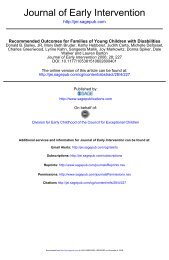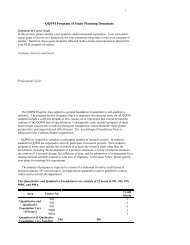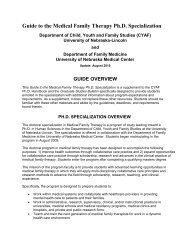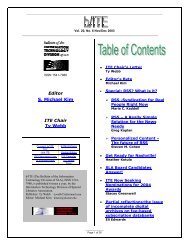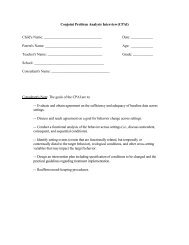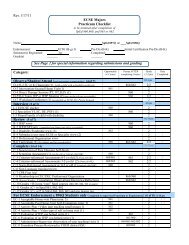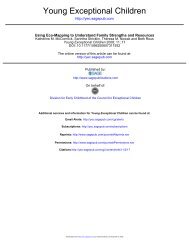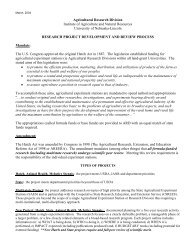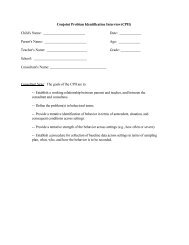The Asset-Based Context Matrix
The Asset-Based Context Matrix
The Asset-Based Context Matrix
Create successful ePaper yourself
Turn your PDF publications into a flip-book with our unique Google optimized e-Paper software.
118 Topics in Early Childhood Special Education 24:2<br />
children in a museum. In L. B. Resnick & J. M. Levine (Eds.),<br />
Perspectives on socially shared cognition (pp. 226–256). Washington,<br />
DC: American Psychological Association.<br />
Guberman, S. R. (1999). Supportive environments for cognitive development:<br />
Illustrations from children’s mathematical activities outside<br />
of school. In A. Göncü (Ed.), Children’s engagement in the<br />
world: Sociocultural perspectives (pp. 202–227). Cambridge,<br />
England: Cambridge University Press.<br />
Hanft, B. E., & Pilkington, K. O. (2000). <strong>The</strong>rapy in natural environments:<br />
<strong>The</strong> means or end goal for early intervention? Infants and<br />
Young Children, 12(4), 1–13.<br />
Harris, S. R., & McEwen, I. R. (1996). Asessing motor skills. In M.<br />
McLean, D. B. Bailey, & M. Wolery (Eds.), Assessing infants and preschoolers<br />
with special needs (pp. 305–333). Columbus, OH: Merrill.<br />
Hresko, W., Miguel, S., Sherbenou, R., & Burton, S. (1994). Developmental<br />
Observation Checklist System: A systems approach to assessing<br />
very young children. Austin, TX: PRO-ED.<br />
Kellegrew, D. H. (1998). Creating opportunities for occupation: An intervention<br />
to promote the self-care independence of young children<br />
with special needs. American Journal of Occupational <strong>The</strong>rapy, 52,<br />
457–465.<br />
Linder, T. W. (1990). Transdisciplinary play-based assessment: A functional<br />
approach to working with young children. Baltimore: Brookes.<br />
McWilliam, R., Ferguson, A., Harbin, G., Porter, D. M., & Vaderviere,<br />
P. (1998). <strong>The</strong> family-centeredness of individualized family services<br />
plans. Topics in Early Childhood Special Education, 18, 69–82.<br />
Meisels, S. J. (1996). Charting the continuum of assessment and intervention.<br />
In S. J. Meisels & E. Fenichel (Eds.), New visions for the<br />
developmental assessments of infants and young children (pp. 27–<br />
52). Washington, DC: Zero to Three.<br />
Nelson, K. (1999, Winter). Making sense: Language and thought in development.<br />
Developmental Psychologist, 1–10.<br />
Raab, M., & Dunst, C. J. (in press). Early intervention practitioner approaches<br />
to natural environment interventions. Journal of Early Intervention.<br />
Rainforth, B., & Roberts, P. (1996). Physical therapy. In R. A.<br />
McWilliam (Ed.), Rethinking pull-out services in early intervention:<br />
A professional resource (pp. 243–266). Baltimore: Brookes.<br />
Riksen-Walraven, J. M. (1978). Effects of caregiver behavior on habituation<br />
rate and self-efficacy in infants. International Journal of<br />
Behavioral Development, 1, 105–130.<br />
Shelden, M. L., & Rush, D. D. (2001). <strong>The</strong> ten myths about providing<br />
early intervention services in natural environments. Infants and<br />
Young Children, 14(1), 1–13.<br />
Stremel, K., Matthews, P., Wilson, R., Molden, V., Yates, C., Busbea,<br />
B., et al. (1992, December). Facilitating infant/toddler skills in family-child<br />
routines. Paper presented at the Council for Exceptional<br />
Children/Division of Early Childhood International Conference on<br />
Children with Special Needs, Washington, DC.<br />
Walsh, S., Rous, B., & Lutzer, C. (2000). <strong>The</strong> federal IDEA natural environments<br />
provisions. In S. Sandall & M. Ostrosky (Eds.), Young<br />
Exceptional Children Monograph Series No. 2: Natural Environments<br />
and Inclusion (pp. 3–15). Longmont, CO: Sopris West.<br />
Wilcox, J. M., & Shannon, M. S. (1996). Integrated early intervention<br />
practices in speech-language pathology. In R. A. McWilliam (Ed.),<br />
Rethinking pull-out services in early intervention: A professional resource<br />
(pp. 217–242). Baltimore: Brookes.<br />
Wolery, M. (1989). Using assessment information to plan instructional<br />
programs. In D. B. Bailey (Ed.), Assessing infants and preschoolers<br />
with handicaps (pp. 478–495). Englewood Cliffs, NJ: Merrill/<br />
Prentice Hall.<br />
Wolery, M. (1996). Early childhood special and general education. In<br />
R. A. McWilliam (Ed.), Rethinking pull-out services in early intervention:<br />
A professional resource (pp. 185–215). Baltimore: Brookes.<br />
APPENDIX: ASSET-BASED CONTEXT (ABC) MATRIX<br />
Linda L. Wilson and Donald W. Mott<br />
Instructions<br />
<strong>The</strong> <strong>Asset</strong>-<strong>Based</strong> <strong>Context</strong> (ABC) <strong>Matrix</strong> is a functional assessment tool<br />
for parents and practitioners in early childhood and family support<br />
programs to identify existing and potential contextually meaningful and<br />
relevant learning opportunities and activities for children. <strong>The</strong> ABC <strong>Matrix</strong><br />
should be completed by one or more of the child’s parents or other<br />
primary caregivers, with the participation of an early childhood practitioner<br />
when desired. Below are the definitions of the assessment areas<br />
captured by the <strong>Asset</strong>-<strong>Based</strong> <strong>Context</strong> <strong>Matrix</strong>.<br />
Activity Settings are everyday experiences, opportunities, or events<br />
that involve a child’s interactions with people and objects providing<br />
him or her a basis for learning about one’s own abilities (Dunst, 2001).<br />
Activity settings are those everyday activities that happen in the different<br />
places where children and families spend their time.<br />
Interests are the child and family’s likes or preferences. <strong>The</strong>y are<br />
favorite toys, objects, people, or events that encourage engagement and<br />
participation in different activity settings. Interests encourage both expression<br />
of existing abilities and promotion of new learning.<br />
<strong>Asset</strong>s are the abilities, strengths, skills, and capabilities used to<br />
participate in interactions with objects and people and which produce<br />
Note. All components of this Appendix are from <strong>The</strong> <strong>Asset</strong>-<strong>Based</strong> <strong>Context</strong><br />
<strong>Matrix</strong>, by L. L. Wilson and D. W. Mott, 2003, Morganton, NC: Family, Infant<br />
& Preschool Program. Copyright ©2003 by Family, Infant and Preschool<br />
Program. This appendix may be reproduced with the permission of the Family,<br />
Infant and Preschool Program, J. Iverson Riddle Developmental Center, 300<br />
Enola Road, Morganton, NC 28655. Reprinted with permission.<br />
desired social and nonsocial environmental consequences and effects as<br />
part of and because of this participation.<br />
Functional and Meaningful Activities are interactions between<br />
children and their social surroundings in which children use a behavior<br />
purposefully to communicate, move, and interact with objects and people.<br />
<strong>The</strong>y also are those critical activities that are performed for the<br />
child or necessitate the participation of another person (e.g., bathing,<br />
dressing, eating).<br />
Opportunity is the quantity and quality of experiences occurring<br />
in activity settings promoting increased social and nonsocial child participation<br />
in everyday activity (Kellegrew, 1998). Opportunity is the<br />
number of chances and the quality of those chances that children have<br />
in everyday activity. Opportunities set the occasion and promote participation<br />
in everyday activities.<br />
Participation refers to the ways in which a child takes part in everyday<br />
activities. Participation is promoted when caregivers pay explicit<br />
attention to opportunities promoting child behavior that is conventional<br />
and both socially and culturally acceptable. That is, child participation<br />
is increased in ways that provide opportunities to learn,<br />
practice, and perfect abilities that permit a child to “fit” into his or her<br />
social and cultural groups and settings (Dunst, 2001).<br />
Possibilities are new opportunities and ways of participating in<br />
everyday experiences. Possibilities build on the child and family’s existing<br />
interests and assets, current opportunities, and participation, resulting<br />
in new ways of interacting with objects and people, as well as<br />
increased frequency, intensity, and variety of opportunities (Kellegrew,<br />
1998).



